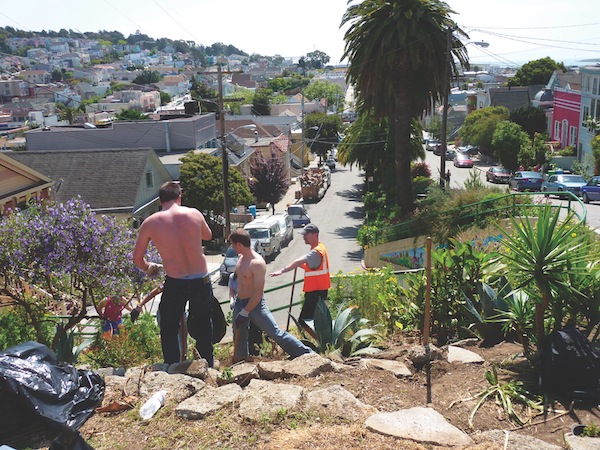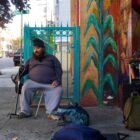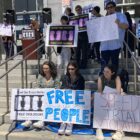Responding to food insecurity, neighbors cultivate network of plots to provide locally grown bounty and education
This story appears in the Spring 2012 print edition of the San Francisco Public Press.
The Quesada Gardens Initiative, which has helped green and revitalize one of San Francisco’s most economically neglected neighborhoods, is struggling to survive as funding is running dry.
Formed in 2002 as a community-building effort by Bayview residents, it has gone on to transform portions of the community, spreading through vacant lots, backyards and community spaces. It has also begun to produce significant quantities of food for a neighborhood where the available of healthy options is limited.
Malnutrition is a problem even in a wealthy city like San Francisco. An estimated 85,000 low-income adults in San Francisco County are “food insecure,” living in fear of hunger or starvation, according to a report last year by a group that researches diet in communities called California Food Policy Advocates, which has offices in Oakland and Los Angeles.
“Especially since the recession, the poverty rates are quite extreme,” said Anne Lee Eng, environmental justice program manager for San Francisco’s Department of the Environment. “People have had to make do with less. The philanthropic community and nonprofits are struggling. Through projects like the Quesada Gardens, people learn to leverage resources and share. People are learning to build those partnerships themselves.”
Quesada Gardens has been able to spread through vacant lots, backyards and community spaces in the Bayview, thanks to ample volunteer labor and government grants that have now ended. More than two-thirds of the gardens’ $296,000 in funding since its founding in 2002 has come from government sources. A little more than $5,000 came from individual donors and $87,000 came from a combination of foundation and corporate donations.
The bulk of the funds came from a now closed environmental justice grant program that resulted from the closure of the polluting Pacific Gas and Electric Co. power plant.
“Place-based, grassroots community building projects are multiplying for all the right reasons,” Jeff Betcher, one of the organizers of the project. “They produce sustainable social and environmental change at a fraction of the cost of top-down approaches. Yet we haven’t identified a reliable revenue stream to cover even that fraction.”
The group’s members fear what the future may hold without the support of government grants. “We are woefully underfunded,” Betcher said. “We are barely holding on. It is very likely Quesada won’t be around next year. It’s hard to say what would happen to the gardens.”
National recognition
The Quesada Gardens Initiative sees itself as a social movement and has earned the city a 2012 Gardens and Green Spaces Award from the United States Conference of Mayors. One of its newer collaborations, the Bridgeview Teaching and Learning Garden on Bridgeview and Newhall streets was awarded the Neighborhood Empowerment Network’s 2011 Best Green Community Project.
Quesada Gardens also sponsors public art, education, health and other community building programs. “It’s important to get people involved in the creative process,” Betcher said.
“They used recycled materials to build,” said Daniel Homsey, director of strategic initiatives for the city administrator’s office. “They’ve nurtured relationships between neighbors, with local schools and universities.”
The Bridgeview Garden has produced 1,650 pounds of food so far. Quesada gardeners have also become active in social policy and research in the fields of public health, community-building and building social capital for future projects.
Quesada Gardens grew an estimated 10,000 pounds of food each year throughout Bayview-Hunters Point, a densely populated neighborhood that has one of the highest unemployment rates in the city and severe public health problems, according to a report by the Healthy Communities Initiative and the Hospital Council of Northern and Central California.
With several huge mixed-income housing developments in the works, the neighborhood is expected to double its population in 20 years.
Sign-up sheets indicate that at least 2,400 people have been involved with Quesada Gardens since its founding, though those records leave many people off. Two-thirds of participants are Bayview-Hunters Point residents.
“We can quantify this increase in green space corresponds to a decrease in crime and the increase in property values,” said Mei Ling Hui, urban forest coordinator at the Department of the Environment.
Quesada Gardens has become a network of public art and spaces, community gardens, free educational resources and more than 20 backyard gardens. It has also helped create a garden for the Cornerstone Missionary Baptist Church on Third and Paul streets.
“We won’t do it for you, but we’ll teach you how,” said Joel McClure, a co-founder of Bridgeview Garden. Each project has its own local leaders, lending the projects flexibility within Quesada Gardens’ network.
Typically, between 12 and 18 volunteers come to Quesada Gardens every weekend to work the land and eat together.
“This garden provides safety and security,” Eng said.
She added that Bayview is the neighborhood with the highest hospitalization rate, and that the garden project could help prevent disease.
Extra hours
Organizers also cite the community-building benefits of the project. Cars driving by the gardens frequently slow down, honk and shout “good job!” McClure said the projects have become places for “drive-by exchanges” of encouragement.
“People think we are all about gardening,” Betcher said. “That’s not our main goal. Social cohesion and community strength naturally allow positive environmental and social developments.”
Quesada Gardens’ staff consists of eight “food guardians,” including a horticultural educator, a volunteer coordinator and a project leader coordinator. They are each paid about $8,000 a year, without benefits. Officially they work part time, but they also give innumerable volunteer hours.
“It is professional-level work, and they deserve to be paid for it,” Betcher said.
Having paid staff has allowed Quesada Gardens to do policy research and advocacy, and provide free educational programs.
“We are beautifying the neighborhood, we are reducing obesity and carbon emissions,” Betcher said. “Hold us to goals, but it needs to be about the people we’re reaching. Foundations have no category for us.”
Ling said she hopes Quesada Gardens won’t go under in 2012. “Their work has been very inspiring,” she said. “I don’t think we could quantify the loss.”
Betcher remains optimistic.
“I see the gap in private foundations funding social sustainability as an opportunity in social policy,” he said.










